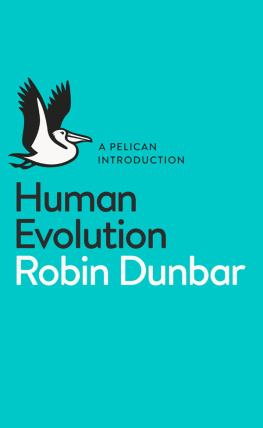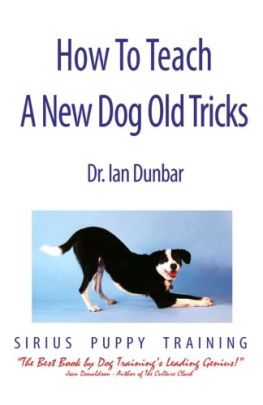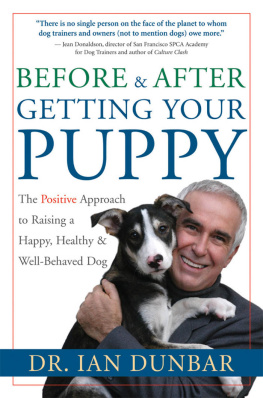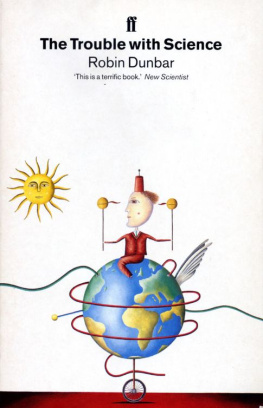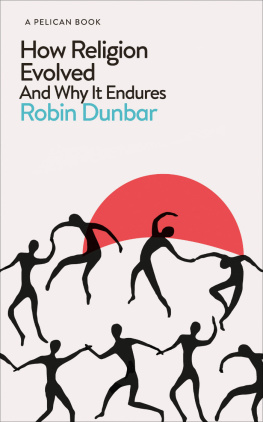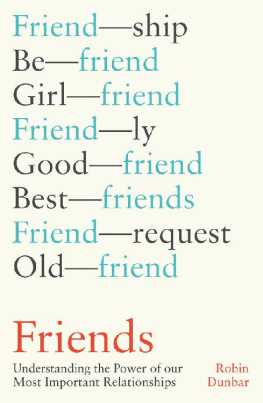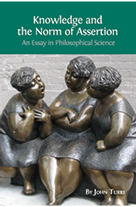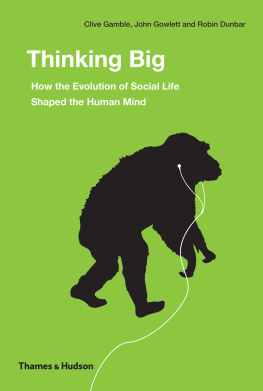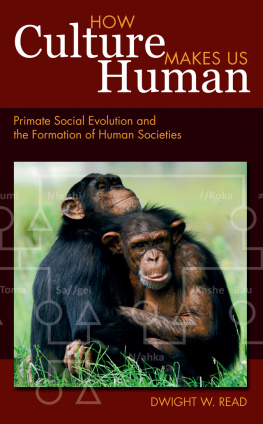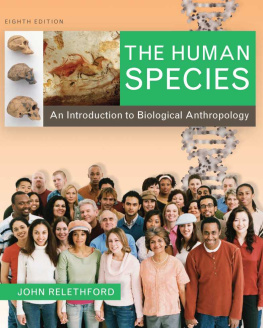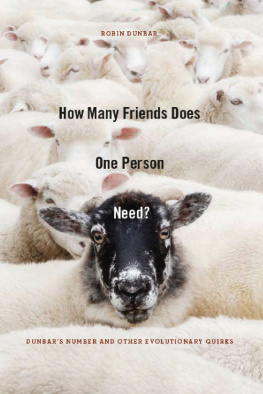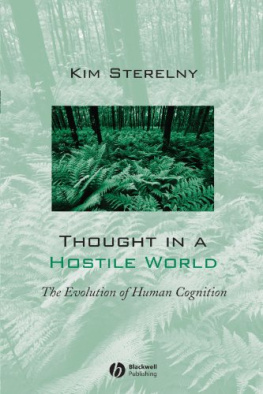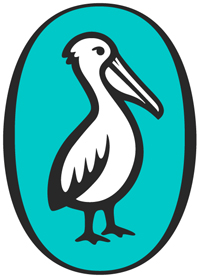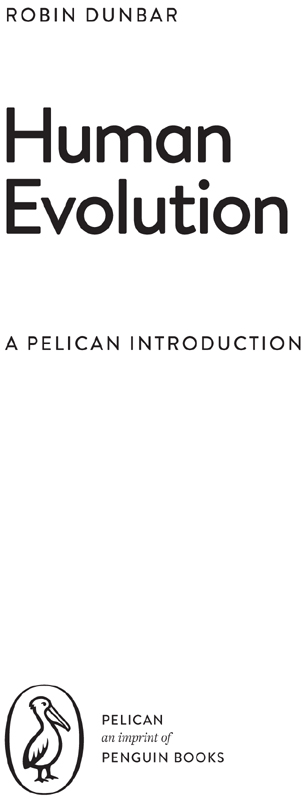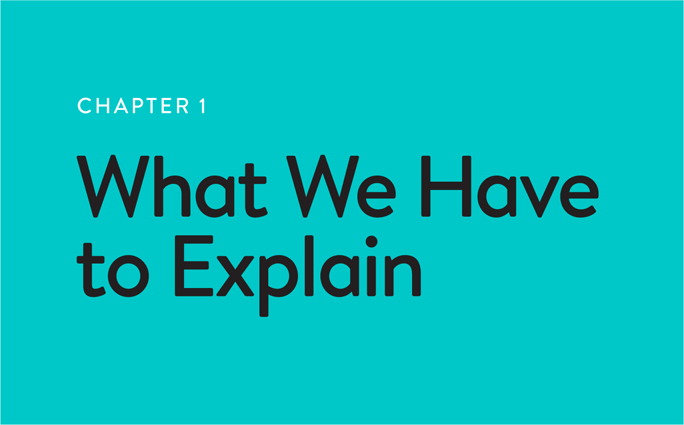PELICAN BOOKS
Published by the Penguin Group
Penguin Books Ltd, 80 Strand, London WC2R 0RL , England
Penguin Group (USA) Inc., 375 Hudson Street, New York, New York 10014, USA
Penguin Group (Canada), 90 Eglinton Avenue East, Suite 700, Toronto, Ontario, Canada M4P 2Y3 (a division of Pearson Penguin Canada Inc.)
Penguin Ireland, 25 St Stephens Green, Dublin 2, Ireland (a division of Penguin Books Ltd)
Penguin Group (Australia), 707 Collins Street, Melbourne, Victoria 3008, Australia (a division of Pearson Australia Group Pty Ltd)
Penguin Books India Pvt Ltd, 11 Community Centre, Panchsheel Park, New Delhi 110 017, India
Penguin Group (NZ), 67 Apollo Drive, Rosedale, Auckland 0632, New Zealand (a division of Pearson New Zealand Ltd)
Penguin Books (South Africa) (Pty) Ltd, Block D, Rosebank Office Park, 181 Jan Smuts Avenue, Parktown North, Gauteng 2193, South Africa
Penguin Books Ltd, Registered Offices: 80 Strand, London WC2R 0RL , England
First published 2014
Copyright Robin Dunbar, 2014
All rights reserved
The moral right of the author has been asserted
Typeset by Jouve (UK), Milton Keynes
ISBN: 978-0-141-97532-0
www.pelicanbooks.com
www.penguin.com
THE BEGINNING
Let the conversation begin...
www.pelicanbooks.com
Follow the Penguin Twitter.com@penguinukbooks
Keep up-to-date with all our stories YouTube.com/penguinbooks
Pin Penguin Books to your Pinterest
Like Penguin Books on Facebook.com/penguinbooks
Find out more about the author and
discover more stories like this at Penguin.co.uk
For
Zaila, Jared and Arran
Acknowledgements
Much of the research on which this book is based was carried out as part of the British Academys Centenary Research Project Lucy to Language: The Archaeology of the Social Brain. Important aspects of the story are based on allied research projects funded by the Leverhulme Trust, the Engineering and Physical Sciences Research Council and the Economic and Social Research Council, two separate European Union research grants (the SocialNets and the ICTe-Collective projects) and, last but not least, an Advanced Grant from the European Research Council. I am extremely grateful to all my colleagues on these projects, without whose contributions this book would have been impossible. Ellie Pearce prepared the maps and . The line drawings are by Arran Dunbar.
The story of human evolution has fascinated us like no other: we seem to have an insatiable curiosity about who we are and where we have come from. Conventionally, this story has always been told in terms of the bones and stones that make up the archaeological record for the very good reason that this is often all we have to go on with any certainty. For the last half century, archaeologists have been loath to stray far from the hard evidence lest they be accused of being speculative. Yet the stones and the bones skirt around what is perhaps the real story of human evolution, namely the social and the cognitive changes that, step by slow and uncertain step, gave rise to modern humans. It is here that the really big questions lie: What is it to be human (as opposed to being an ape)? And how did we come to be that way?
We are great apes, since we share with this family most of our biological, genetic and ecological traits. By current consensus, the rest of this family consists of two species of chimpanzees (members of the genus, or biological family, Pan), two (maybe four) species of gorillas (genus Gorilla) and two (maybe three) species of orang utans (genus Pongo). Of these, only the orangs live outside Africa: they are now confined exclusively to the southeast Asian islands of Borneo and Sumatra, although until the end of the last Ice Age some 10,000 years ago, they were widespread in Indo-China and the southern parts of the Chinese mainland.
Until about 1980, the conventional view of our relationship with the great apes was that we undoubtedly belonged to the great ape family, but we and our ancestor species formed a separate subfamily from the other apes. This is because we differ from them in a number of very tangible ways: we walk upright while they walk on all fours, they have large brains by primate standards but ours are so much larger still, we have culture but they merely behave. This picture suggested an early division in the ape ancestry between the lineage leading to modern humans and the one leading to all the other great apes. Since the orang utan lineage can be documented in the fossil record back to around 16 million years ago, it followed that our common ancestor with the apes must have been at least this old.
However, the story changed dramatically during the 1980s when it became possible to look at the genetic (as opposed to purely anatomical) similarities between different species. It soon became apparent that humans are in fact genetically more closely related to the chimpanzees than either of us is to any of the other great apes, though the gorillas come a close second. It is the orang utan isolated in Asia some 16 million years ago that is the odd one out. The several species of living African apes (humans, gorillas and chimpanzees) form a single lineage that didnt split up until a much more modest 68 million years ago (). We belong not to a separate subfamily within the great apes family, but to the subfamily of African great apes. Because we share a common ancestor with the chimpanzees, it makes the chimpanzees (as opposed to some kind of generic early Miocene great ape) the proper comparison for the human lineage, and in many ways the best model for early members of the human lineage (the australopithecines and their immediate predecessors).
So to set the story into context, let me briefly recap the evolutionary history of the African great ape family and our place within it. With this as our background, I will then sketch out five major evolutionary phases that characterize our lineage after its separation from the other African great apes. These phases, or transitions, will be the framework around which I will construct my story of human evolution.
The story so far
The living great apes (including the orang) are the descendants of a dramatic flowering of ape species during the early Miocene era beginning 20 million or so years ago, first in Africa and later in Europe and Asia (). Around 10 million years ago, a progressive drying of the climate dramatically reduced the great tropical forests that had been home to this rich diversity of apes during the Miocene. Dozens of species of apes died out, and were replaced by the much more adaptable monkeys who, until then, had been bit-part players on the African and Asian primate scene. One African ape lineage, however, survived and became the common ancestor of the living African great apes. Then, around 8 million years ago, what was to become the gorilla lineage split off. Some 2 million years later, the lineage that eventually gave rise to modern humans diverged from the humanchimpanzee ancestor (usually known as the Last Common Ancestor, or LCA) and set off on its own evolutionary trajectory. Much later still, around 2 million years ago at about the same time as the genus

